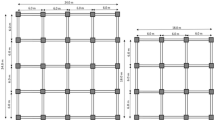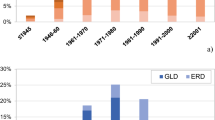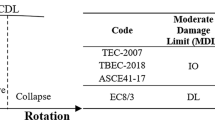Abstract
An analytical seismic fragility assessment framework is presented for the existing low strength reinforced concrete structures more common in the building stock of the developing countries. For realistic modelling of such substandard structures, low strength concrete stress-strain and bond-slip capacity models are included in calibrating material models. Key capacity parameters are generated stochastically to produce building population and cyclic pushover analysis is carried out to capture inelastic behaviour. Secant period values are evaluated corresponding to each displacement step on the capacity curves and used as seismic demand. A modified capacity demand diagram method is adopted for the degrading structures, which is further used to evaluate peak ground acceleration from back analysis considering each point on the capacity curve as performance point. For developing fragility curves, the mean values of peak ground acceleration are evaluated corresponding to each performance point on the series of capacity curves. A suitable probability distribution function is adopted for the secant period scatter at different mean peak ground acceleration values and probability of exceedance of limit states is evaluated. A suitable regression function is used for developing fragility curves and regression coefficients are proposed for different confidence levels. Fragility curves are presented for a low rise pre-seismic code reinforced concrete structure typical of developing countries.
Similar content being viewed by others
References
Ahmad S (2011), “Seismic Vulnerability of Nonductile Reinforced Concrete Structures in Developing Countries,” Ph.D Thesis, The University of Sheffield, U.K.
Ahmad S, Pilakoutas K, Neocleous K and Zaman Q U (2014), “Stress-strain Model for Low Strength Concrete in Uni-axial Compression,” Arabian Journal of Science and Engineering, DOI: 10.1007/s13369-014-1411-1, 20(2): 313–328.
Ahmed M (2006), “Earthquake Loss Estimation and Structural Vulnerability Assessment for Greater Cairo,” Ph.D Thesis.
ATC-40 (1996), Seismic Evaluation and Retrofit of Concrete Buildings, Publication of Applied Technology Council, Redwood City, California.
Calvi GM (1999), “A Displacement-based Approach for Vulnerability Evaluation of Classes of Buildings,” Journal of Earthquake Engineering, 3: 411–438.
Calvi GM, Pinho R and Crowley H (2006) “Stateof- the-knowledge on the Period Elongation of RC Buildings during Strong Ground Shaking,” First European Conference on Earhquake Engineering and Seismology, Geneva.
Celik OC and Ellingwood BR (2008), “Modeling Beamcolumn Joints in Fragility Assessment of Gravity Load Designed Reinforced Concrete Frames,” Journal of Earthquake Engineering, 12: 357–381.
Celik OC and Ellingwood BR (2010), “Seismic Fragilities for Non-ductile Reinforced Concrete Frames–role of Aleatoric and Epistemic Uncertainties,” Structural Safety, 32: 1–12.
Cornell CA, Jalayer F, Hamburger RO and Foutch DA (2002), “Probabilistic Basis for 2000 sac Federal Emergency Management Agency Steel Moment Frame Guidelines,” Journal of Structural Engineering, ASCE, 128(4): 526–533.
Crowley H, Pinho R and Bommer J (2004), “A Probabilistic Displacement-based Vulnerability Assessment Procedure for Earthquake Loss Estimation,” Bulletin of Earthquake Engineering, 2(2): 173–219.
Dipasquale E and Cakmak AS (1988), “Identification of the Serviceability Limit State and Detection of Seismic Structural Damage,” Report NCEER-88-0022, National Centre for Earthquake Engineering Research, State University of New York at Buffalo, NY.
Dymiotis C, Kappos AJ and Chryssanthopoulos MK (1999), “Seismic Reliability of RC Frames with Uncertain Drift, and Member Capacity,” Journal of Structural Engineering, ASCE, 125(9): 1038–1047.
Erberik MA (2008), “Fragility-based Assessment of Typical Mid-rise and Low-rise RC Buildings in Turkey,” Engineering Structures, 30: 1360–1374.
Erberik MA and Elnashai AS (2005), “Seismic Vulnerability of Flat Slab Structures,” Technical Report, Mid America Earthquake Centre, University of Illinois at Urbana-Champaign.
FEMA356 (2000), Prestandard and Commentary for the Seismic Rehabilitation of Buildings, Federal Emergency Management Agency, Washington DC.
FEMA440 (2005), Improvement of Nonlinear Static Seismic Analysis Procedures, Applied Technology Council (ATC-55 Project), Redwood City, California.
Franchin P, Lupoi A, Pinto PE and Schotanus MIJ (2003), “Sesimic Fragility of Reinforced Concrete Structures Using a Response Surface Approach,” Journal of Earthquake Engineering, 7(1) Special Issue: 45–77.
Gardoni P, Mosalam KM and Der Kiureghian A (2003), “Probabilistic Seismic Demand Models and Fragility Estimates for RC Bridges,” Journal of Earthquake Engineering, 7(1) Special Issue: 79–106.
Kyriakides N (2008), “Seismic Vulnerability Assessment of RC Buildings and Risk Assessment for Cyprus,” Ph.D Thesis, The University of Sheffield.
Kyriakides N, Ahmad S, Pilakoutas K, Neocleous K and Chrysostomou C (2014), “A Probabilistic Analytical Seismic Vulnerability Assessment Framework for Substandard Structures in Developing Countries,” Earthquake and Structures, 6(6): 665–687.
Kyriakides N, Pilakoutas K and Ahmad S (2012), “Vulnerability Curves for RC Substandard Buildings,” 15th World Conference on Earthquake Engineering (WCEE), Lisbon.
Lang K (2002), “Seismic Vulnerability of Existing Buildings,” PhD thesis, Swiss Fedearal Institute of Technology, Zurich.
Mander JB, Priestley MJN and Park R (1988), “Theoretical Stress-strain Model for Confined Concrete,” Journal of Structural Engineering, ASCE, 114(8): 1804–1826.
McKay M, Conover W and Beckman R (1979), “A Comparison of Three Methods for Selecting Values of Input Variables in the Analysis of Output from a Computer Code,” Technometrics, 21: 239–245.
Mosalam K, Ayala G, White R and Roth C (1997), “Seismic Fragility of l RC Frames with and without Masonry Infill Walls,” Journal of Earthquake Engineering, 1: 693–720.
Pinho R, Bommer JJ and Glaister S (2002), “A Simplified Approach to Displacement-based Earthquake Loss Estimation Analysis,” Proceedings of the 12th European Conference on Earthquake Engineering, London, U.K., Paper no. 738.
Prakash V, Powell G and Campbell S (1994), “Drain-3d Base Program Description and User Guide, Version 1.10,” Report No. UCB/SEMM-94/07, Department of Civil Engineering, University of California, Berkeley.
Ramamoorthy S, Gardoni P and Bracci J (2006), “Probabilistic Demand Models and Fragility Curves for Reinforced Concrete Frames,” Journal of Structural Engineering, ASCE, 132(10): 1563–1572.
Rossetto T and Elnashai AS (2005), “A New Analytical Procedure for the Derivation of Displacement-based Vulnerability Curves for Population of RC Structures,” Engineering Structures, 27(3): 397–409.
Sezen H and Moehle JP (2004), “Shear Strength Model for Lightly Reinforced Concrete Columns,” Journal of Structural Engineering, ASCE, 130(11): 1692–1703.
Singhal A and Kiremidjian A (1997), “A Method for Earthquake Motion-damage Relationships with Application to Reinforced Concrete Frames,” NCEER Report NCEER-97-0008, State University of New York at Buffalo, USA.
Zembaty Z, Kowalski M and Pospisil S (2006), “Dynamic Identification of an RC Frame in Progressive States of Damage,” Engineering Structures, 28(5): 668–681.
Author information
Authors and Affiliations
Corresponding author
Rights and permissions
About this article
Cite this article
Ahmad, S., Kyriakides, N., Pilakoutas, K. et al. Seismic fragility assessment of existing sub-standard low strength reinforced concrete structures. Earthq. Eng. Eng. Vib. 14, 439–452 (2015). https://doi.org/10.1007/s11803-015-0035-0
Received:
Accepted:
Published:
Issue Date:
DOI: https://doi.org/10.1007/s11803-015-0035-0




